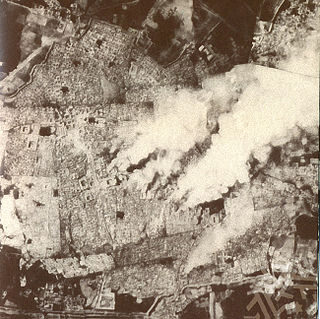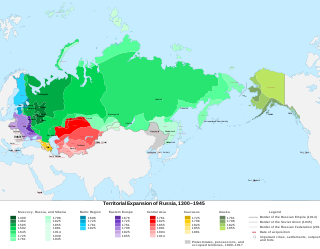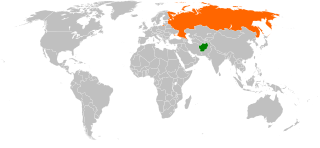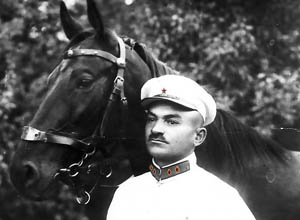
The Russian Civil War was a multi-party civil war in the former Russian Empire sparked by the overthrowing of the monarchy and the new republican government's failure to maintain stability, as many factions vied to determine Russia's political future. It resulted in the formation of the RSFSR and later the Soviet Union in most of its territory. Its finale marked the end of the Russian Revolution, which was one of the key events of the 20th century.

Tajikistan harkens to the Samanid Empire (819–999). The Tajik people came under Russian rule in the 1860s. The Basmachi revolt broke out in the wake of the Russian Revolution of 1917 and was quelled in the early 1920s during the Russian Civil War. In 1924 Tajikistan became an Autonomous Soviet Socialist Republics of the Soviet Union, the Tajik ASSR, within Uzbekistan. In 1929 Tajikistan was made one of the component republics of the Soviet Union – Tajik Soviet Socialist Republic – and it kept that status until gaining independence 1991 after the dissolution of the Soviet Union.

The Soviet–Afghan War (1979–1989) was a conflict wherein insurgent groups known collectively as the Mujahideen, as well as smaller Marxist–Leninist–Maoist groups, fought a nine-year guerrilla war against the Democratic Republic of Afghanistan (DRA) and the Soviet Army throughout the 1980s, mostly in the Afghan countryside. The Mujahideen were variously backed primarily by the United States, Pakistan, Iran, Saudi Arabia, China, and the United Kingdom; the conflict was a Cold War-era proxy war. Between 562,000 and 2,000,000 Afghans were killed and millions more fled the country as refugees, mostly to Pakistan and Iran. Between 6.5%–11.5% of Afghanistan's population is estimated to have perished in the conflict. The war caused grave destruction in Afghanistan, and it has also been cited by scholars as a contributing factor to the dissolution of the Soviet Union and the end of the Cold War, in hindsight leaving a mixed legacy to people in both territories.
The ten years 1917–1927 saw a radical transformation of the Russian Empire into a socialist state, the Soviet Union. Soviet Russia covers 1917–1922 and Soviet Union covers the years 1922 to 1991. After the Russian Civil War (1917–1923), the Bolsheviks took control. They were dedicated to a version of Marxism developed by Vladimir Lenin. It promised the workers would rise, destroy capitalism, and create a socialist society under the leadership of the Communist Party of the Soviet Union. The awkward problem was the small proletariat, in an overwhelmingly peasant society with limited industry and a very small middle class. Following the February Revolution in 1917 that deposed Nicholas II of Russia, a short-lived provisional government gave way to Bolsheviks in the October Revolution. The Bolshevik Party was renamed the Russian Communist Party (RCP).

The Basmachi movement was an uprising against Russian Imperial and Soviet rule by the Muslim peoples of Central Asia.

Finland participated in the Second World War initially in a defensive war against the Soviet Union, followed by another battle against the Soviet Union acting in concert with Nazi Germany and then finally fighting alongside the Allies against Germany.

Allied intervention in the Russian Civil War consisted of a series of multi-national military expeditions which began in 1918. The Allies first had the goal of helping the Czechoslovak Legion in securing supplies of munitions and armaments in Russian ports. At times between 1918 and 1920 the Czechoslovak Legion controlled the entire Trans-Siberian Railway and several major cities in Siberia. By 1919 the goal was to help the White forces in the Russian Civil War. When the Whites collapsed the forces were withdrawn by 1920.

Relations between the Soviet Unionand Japan between the Communist takeover in 1917 and the collapse of Communism in 1991 tended to be hostile. Japan had sent troops to counter the Bolshevik presence in Russia's Far East during the Russian Civil War, and both countries had been in opposite camps during World War II and the Cold War. In addition, territorial conflicts over the Kuril Islands and South Sakhalin were a constant source of tension. These, with a number of smaller conflicts, prevented both countries from signing a peace treaty after World War II, and even today matters remain unresolved.

The borders of Russia changed through military conquests and by ideological and political unions in the course of over five centuries (1533–present).

The Sino-Soviet conflict of 1929 was an armed conflict between the Union of Soviet Socialist Republics and Chinese warlord Zhang Xueliang of the Republic of China over the Chinese Eastern Railway.

The partition of the Ottoman Empire was a geopolitical event that occurred after World War I and the occupation of Constantinople by British, French and Italian troops in November 1918. The partitioning was planned in several agreements made by the Allied Powers early in the course of World War I, notably the Sykes-Picot Agreement, after the Ottoman Empire had joined the Ottoman–German Alliance. The huge conglomeration of territories and peoples that formerly comprised the Ottoman Empire was divided into several new states. The Ottoman Empire had been the leading Islamic state in geopolitical, cultural and ideological terms. The partitioning of the Ottoman Empire after the war led to the domination of the Middle East by Western powers such as Britain and France, and saw the creation of the modern Arab world and the Republic of Turkey. Resistance to the influence of these powers came from the Turkish National Movement but did not become widespread in the other post-Ottoman states until the period of rapid decolonization after World War II.

Relations between Afghanistan and Russia first emerged in the 19th century. At the time they were placed in the context of "The Great Game", Russian–British confrontations over Afghanistan from 1840 to 1907. The Soviet Union was the first country to establish diplomatic relations with Afghanistan following the Third Anglo-Afghan War in 1919. On 28 February 1921, Afghanistan and Soviet Russia signed a Friendship Treaty. The Soviet Union intervened in Afghanistan against the Basmachi movement in 1929 and 1930.
Urta Tagay is a river island in the middle of the river Panj on the border of Afghanistan and Tajikistan in Central Asia. It lies between the towns Farkhor and Yangi Qala. It is administered by Takhar Province, Afghanistan. It was the subject of two border conflicts: one in 1913 and one in 1925.

The Bukharan People's Soviet Republic was a short-lived Soviet state that governed the former Emirate of Bukhara during the years immediately following the Russian Revolution. In 1924, its name was changed to the Bukharan Socialist Soviet Republic. After the redrawing of regional borders, its territory was assigned mostly to the Uzbek SSR and some to the Turkmen SSR.

Konstantin Petrovich Nechaev was an Imperial Russian Army officer and White movement leader, who commanded a large Russian mercenary army in China from 1924 to 1929. Fighting for the Fengtian clique warlords Zhang Zuolin and Zhang Zongchang, Nechaev took part in several wars of the Chinese Warlord Era until his mercenary force was destroyed in the Northern Expedition. Thereafter, he mostly retired from military service and became a White émigré community leader in Manchuria. Captured by SMERSH during the Soviet invasion of Manchuria, Nechaev was executed by Soviet authorities in 1946.
The Bukharan Revolution refers to the events of 1917–1925, which led to the elimination of the Emirate of Bukhara in 1920, the formation of the Bukharan People's Soviet Republic, the intervention of the Red Army, the mass armed resistance of the population, suppression of Basmachi, the inclusion of Bukhara People’s Soviet Republic into the Soviet Union on September 19, 1924 as a separate union republic, and the elimination of the newly established republic as a result of national disengagement and the formation of the Uzbek SSR, the Turkmen SSR and Tajik ASSR in 1924.
The Urtatagai conflict was a conflict between the Emirate of Afghanistan and the Russian Empire over control of the island of Urtatagai, which took place 1913. It began in November, when Afghan troops were deployed on Urtatagai after it had merged with the Afghan bank, placing it within Afghan territory. Sometime later, the flow of the river once again separated the island, and on an agreement on 13 December at Askhabad, the Afghan leadership agreed to return the island, ending the conflict.

The Emirate of Afghanistan was an unrecognized state ruled by the Saqqawists that existed from January to October 1929. Habibullāh Kalakāni became the state's only emir on 18 January 1929. After the fall of Kalakani on 13 October 1929, the Emirate ended.

Yakov Arkadievich Melkumov was a Soviet military commander of Armenian origin. He fought in the First World War and the Russian Civil War. He particularly distinguished himself during the Russian Civil War fighting against the Basmachi movement on the Turkestan Front. He is known for commanding the unit that killed the former Ottoman general and commander of the Basmachi rebels, Enver Pasha.
Shir Muhammad-bek Gazi, also known as Mahmud-Bek also known under the nickname Korshirmat was a prominent figure of the Basmachi Movement in exile since 1923, the first head of the Turkestan Union during the Great Patriotic War with the support of the Abwehr to restore the insurrectionary movement in Turkestan.














